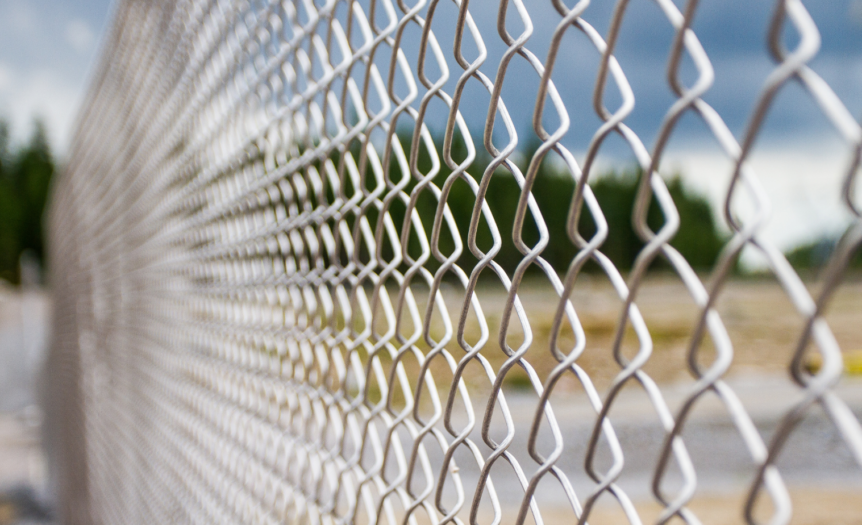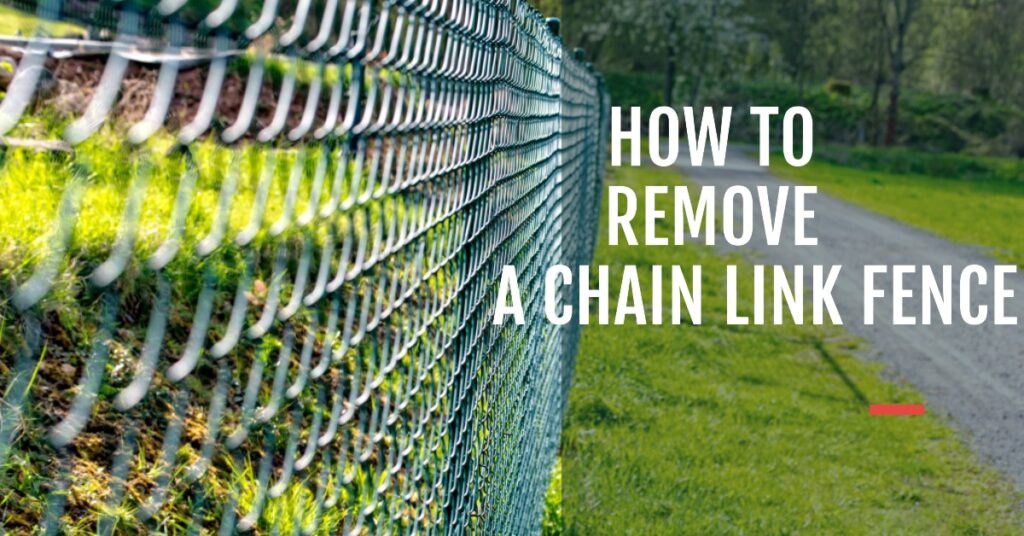Are you tired of that old chain link fence surrounding your property and looking to replace it with something more visually appealing?
Good news – removing a chain link fence is simpler than you might think, even for those who have never taken on a DIY project before.
In this blog post, we’ll provide step-by-step instructions on how to remove a chain link fence quickly and efficiently while preserving your garden’s plants and structures.
Tools And Materials Needed For Chain Link Fence Removal
To remove a chain link fence, you will need the following tools and materials: gloves to protect your hands from cuts and scratches, wire cutters for removing the fence ties, bolt cutters for cutting any stubborn wires or bolts, a crowbar to pry off posts that are cemented into the ground, and a shovel to dig out dirt around the posts.
Gloves
Wearing gloves is an essential part of the chain link fence removal process, as they not only provide protection for your hands but also ensure a firm and secure grip while handling tools and materials.
For example, imagine using wire cutters to snip through chain links or bolt cutters to trim off stubborn parts of the fence – without gloves on, you risk injury from sharp edges or frayed wires.
Gloves also offer an added layer of safety when digging out fence posts or removing concrete footings with a shovel or crowbar. Furthermore, a good pair of gloves can prove invaluable in preserving delicate plants near the project area by guarding against accidental damage caused by mishandling equipment.
Video Credit (The Dan Chan)
Wire Cutters
Wire cutters are an essential tool when it comes to removing a chain link fence. They are necessary for cutting the ties that hold the fencing fabric in place and for snipping off any excess wire after detaching the fence from its posts.
It’s important to choose sturdy, sharp wire cutters capable of cutting through thick metal wires without losing their grip.
Using dull or rusty wire cutters can cause frustration and make the task more challenging than it already is. To avoid this, invest in quality wire cutters that will make your job easier and quicker.
Remember to keep your hands protected by wearing gloves while using them since you’ll be working with sharp metal wires throughout most of the removal process.
Bolt Cutters
Bolt cutters are extremely helpful tools for removing a chain link fence. These powerful tools can easily snap through thick metal wires, making the process of cutting and separating the ties on your fence much easier.
To use bolt cutters effectively, start at one end of the fence and work your way towards the other, ensuring that you cut every tie.
Having bolt cutters on hand will also allow you to quickly remove any locks or secure fasteners attached to your fencing. This is especially useful if you need to dismantle multiple sections of fencing that are tied together with locking mechanisms.
Crowbar
A crowbar is a versatile tool that can come in handy when removing a chain link fence. It can be used to pry apart stubborn posts, loosen concrete footing, and help with the removal of the fence fabric.
To remove stubborn posts, insert the end of the crowbar between the post and concrete footing and apply pressure to loosen it from the ground. For loosening concrete footing, you can use a crowbar as leverage while rocking back and forth until it cracks off.
A word of caution: If you encounter any electrical wiring or gas lines during your fence-removal process call your local experts immediately! Depending on where you live, there may even be required permits needed for larger projects like this one too!
Overall, having a sturdy crowbar along with other necessary tools will make your chain-link fence removal project go much smoother.
Shovel
Another essential tool for removing a chain link fence is the trusty shovel. This will come in handy when it’s time to remove the posts and their concrete footings from the ground.
Start by digging around the post to loosen up any soil or debris that may be holding it in place.
When all else fails, a farm jack can also come in handy with stubborn posts or concrete footings that won’t budge. Remember, safety should always come first when using heavy machinery like this.
Protect yourself with gloves and eye protection at all times while working on fence removal projects.
Steps For Removing A Chain Link Fence
To remove a chain link fence, start by detaching the fence ties with wire cutters and removing the top rail using a crowbar. Next, take out the line and end posts before rolling up and removing the chain link fabric.
Detaching The Fence Ties
Before you start dismantling your chain-link fence, it’s essential to remove the ties that secure the chain link fabric in place. Fence ties are small metal wires that connect the mesh to the top rail and line posts.
You’ll need a pair of pliers or wire cutters to snip them off one by one.
If some of the ties are too tight or rusted, spraying a lubricant like WD-40 on them can make it easier for you to clip them off. It’s also important to note that different types of chain-link fences come with varying numbers and styles of ties, so take some time initially to study how they were installed in your specific fence.
Removing The Top Rail
The top rail of a chain link fence adds stability and support to the structure. But when it’s time to remove the fence, you’ll need to start by taking off this component first.
To do this, locate the tension bands that hold the top rail in place at each corner post. Using your wire cutters or bolt cutters, carefully loosen and remove these bands.
Once detached, use a crowbar or similar tool to pry up one end of the top rail from its connection point on one corner post.
It’s worth noting that some chain link fences may have additional supports for their top rails such as brace bands or sleeves which must also be removed before detaching any ties holding them in place.
Be sure to keep track of all hardware pieces removed during this process so that they can easily be replaced when installing a new fence later on.
Removing The Line And End Posts
After removing the top rail and rolling up the chain link fabric, it’s time to take out the line and end posts. To start, use a crowbar or shovel to loosen any surrounding dirt or concrete footing around the post.
Once loose, grab onto the post with your hands and see if you can wiggle it back and forth until it comes free from the ground.
Don’t forget that there may be additional supports such as tension bars or brace bands attached to these posts that need removal as well. As always, wear gloves during this process for safety reasons and dispose of all materials properly once removed.
Rolling Up And Removing The Chain Link Fabric
Once the top rail and posts have been removed, it’s time to tackle the actual chain link fabric. Start by loosening the fencing at one end of the section you’re working on.
Unhook any remaining ties that are still holding it in place and carefully unravel any twisted or tangled areas. Once you’ve got a clean section to work with, begin rolling up the fencing material as tightly as possible.
It’s important to wear gloves during this process, both for protection from sharp edges and to prevent getting cut or scratched by rusty metal links. If there are any stubborn spots where the fence won’t come free, try using bolt cutters or wire snips to break through them before continuing with rolling it up.
Removing The Fence Posts And Concrete Footing
After removing the chain link fabric, the next step is to tackle the fence posts and their concrete footing. This can be a challenging task, as these posts are often embedded deep into the ground.
Begin by digging around the base of the post with a shovel to expose as much of the concrete footing as possible.
Once you have exposed enough of the concrete footing around each post, use a farm jack tool to lift them out of the ground. This powerful tool uses mechanical leverage to provide significant lifting force capable of lifting even the most stubborn posts out of their holes.
Be sure to dispose of any removed materials in accordance with local regulations and laws, and consider preparing for replacing your chain-link fence if needed.
Tips For Successful Chain Link Fence Removal
– Work in sections and focus on one area at a time to ensure you don’t get overwhelmed.
Work In Sections
Removing a chain link fence can be a daunting task, but breaking it down into sections can make the job much more manageable. Start by detaching the fence ties from one section of the fence and removing the top rail before moving onto the line and end posts.
Once those are removed, roll up and remove the chain link fabric.
By dividing your project into smaller sections, you’ll also be able to protect nearby plants and structures more easily by only removing what you need to at each time. This approach also makes it easier to dispose of materials as you go, reducing clutter on your property and allowing for efficient cleanup efforts.
Protect Nearby Plants And Structures
Before starting the chain link fence removal process, it’s crucial to consider nearby plants and structures. The last thing you want is to damage your garden or other objects while taking down the fence.
You can protect your surroundings by covering any delicate plants with tarps or blankets.
Additionally, if there are trees or bushes near the fence, make sure they are trimmed back before beginning work. This way, they won’t obstruct your access while removing the fence posts and concrete footing.
Always keep an eye out for vines and weeds that may have grown around the fencing over time as well – cutting these away ahead of time will make disassembling easier in the long run.
Use A Reciprocating Saw Or Angle Grinder To Cut The Fence
One of the most effective ways to remove a chain link fence is by using either a reciprocating saw or an angle grinder. A reciprocating saw is ideal for cutting through larger metal poles, while an angle grinder works best for making precise cuts on smaller pieces of fencing.
Both tools are easy to use and can make quick work of stubborn fence sections that won’t budge with other methods.
For example, if you’re cutting through a particularly thick steel post with a reciprocating saw, it’s essential to take your time and let the blade do the work instead of forcing it through too quickly.
If using an angle grinder on smaller sections, try not to apply too much pressure as this could cause the blade to overheat or break off altogether.
Use A Farm Jack To Lift Out Stubborn Posts
If you’ve got a particularly stubborn fence post that won’t budge, a farm jack may be just the tool you need. A farm jack, also known as a high-lift jack, is a versatile piece of equipment that can lift and move heavy objects with ease.
To use it for removing fence posts, simply place the base of the farm jack under the post and pump the handle up and down to raise the post out of its hole. Keep in mind that this method works best if there’s enough space around the post to maneuver the jack into position.
It’s essential to take safety precautions when using any type of lifting equipment like a farm jack. Always wear gloves and eye protection while working on your fence removal project.
Have A Disposal Plan In Place
Once you’ve successfully removed your chain link fence, it’s important to have a plan for disposing of the materials. Recycling the fencing is an excellent option if possible, and many scrap metal dealers will happily take used chain link fencing off your hands.
Another thing to keep in mind when disposing of the removed fence is that some areas have specific regulations concerning discarded building materials.
Finally, don’t forget about preparing for the replacement fence. Knowing how much new fencing you’ll need and having a budget in place can help prevent unexpected expenses down the line.
Disposing Of The Removed Fence
Once the chain link fence has been removed, it’s important to have a plan for disposing of it properly. Consider recycling the fencing if possible or researching appropriate disposal methods in your area.
Recycle The Fencing If Possible
If you’re looking for an eco-friendly way to dispose of your old chain link fence, consider recycling it. This can be done by taking the fencing to a local scrap metal yard or recycling center that accepts steel.
Before doing so, make sure all non-metal materials have been removed from the fence and only clean metal is being recycled.
Another option is to repurpose the chain link fencing into something new such as a trellis for climbing plants or a frame for outdoor furniture.
Consider Proper Disposal Methods
Once you’ve successfully removed your chain link fence, it’s important to dispose of it in an environmentally friendly way. If the fencing is still intact and in decent shape, consider recycling or reusing it for another project.
Many scrap metal yards will accept chain link fence materials for recycling.
One option is to take your old fencing to a designated landfill that accepts construction debris. Some landfills may also have specific requirements for accepting chain link fences, such as needing them to be rolled up and tied securely.
Another alternative is hiring a waste removal service company that will properly dispose of the materials on your behalf while adhering to environmental regulations.
Prepare For Replacing The Fence
Once you’ve successfully removed your chain link fence, it’s important to have a plan in place for replacing it. Take some time to consider what type of fence will best suit your needs and match the aesthetic of your property.
Before installing the new fence, ensure that the area is cleared of any debris from the old fence removal process. This includes removing any remaining posts and concrete footing.
Make sure you have all necessary materials and tools on hand before beginning installation.
Conclusion
Removing a chain link fence may seem like a daunting task, but with the right tools and steps, it’s an achievable DIY project. Protect nearby plants and structures while using gloves, wire cutters, bolt cutters, crowbar and shovel to remove the fence ties, rail, posts and concrete footing.
Don’t forget to work in sections and have a disposal plan in place for the removed fencing.







